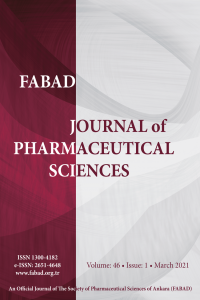The Effects of Gender in Neurological Disorders: A Special Focus on Autism Spectrum Disorders and Thiomersal Toxicity
The Effects of Gender in Neurological Disorders: A Special Focus on Autism Spectrum Disorders and Thiomersal Toxicity
Autism gender, neurodevelopmental disorders, mercury, thiomersal,
___
- Allen, J. S., Damasio, H., Grabowski, T. J., Bruss, J., & Zhang, W. (2003). Sexual dimorphism and asymmetries in the gray-white composition of the human cerebrum. NeuroImage, 18(4), 880–894. https://doi.org/10.1016/s1053-8119(03)00034-x
- ISSN: 1300-4182
- Yayın Aralığı: Yılda 3 Sayı
- Başlangıç: 2005
- Yayıncı: FABAD Ankara Eczacılık Bilimleri Derneği
Selinay Başak ERDEMLİ KÖSE, Aylin BALCI ÖZYURT, Anıl YİRÜN, Pınar ERKEKOĞLU
Biyoparçalanır Doğal ve Sentetik Polimerlerin Yara Örtülerinde Kullanımı
Sümeyra PANCUR, Erem BİLENSOY, Sema ÇALIŞ
Hastaların İlaç Uyumunun Arttırılmasında Toplum Eczacılarının Rolü
Felat ÇELEBİ, Muammer ÇALIKUŞU, Gülbin ÖZÇELİKAY
ABC, VED, and ABC-VED Matrix Analyses for Inventory Management in Community Pharmacies: A Case Study
Leukotriene D4 Levels in Patıents With Breast Cancer
Sevgi AKAYDIN, Sümeyye RAMAZANOĞLU, Ece MİSER SALİHOĞLU, Hasan KARANLIK, Semra DEMOKAN
Enfeksiyon Görüntüleme ve Tedavisi için 177Lutesyum-Tedizolid
Merve KARPUZ, Emre ÖZGENÇ, Evren GÜNDOĞDU, Zeynep BURAK
Gülgun YENER, Caner ACAR, Berna ÖZBEK, Emel MATARACI KARA
Mahmut GÖZELLE, Aysun KILIÇ SÜLOĞLU
İrem BOZBEY, Gülce TAŞKOR ÖNEL, Burçin TÜRKMENOĞLU, Şule GÜRSOY, Esra DİLEK
Ayşe ÇİÇEK KAYA, Hilal ÖZBEK, Hafize YUCA, Gülderen YILMAZ, Zeynebe BİNGÖL, Cavit KAZAZ, İlhami GÜLÇİN, Zuhal GÜVENALP
